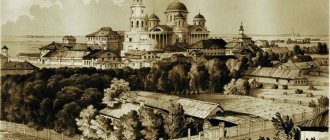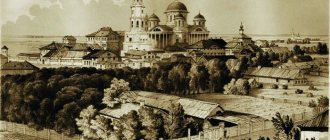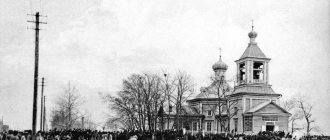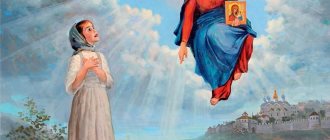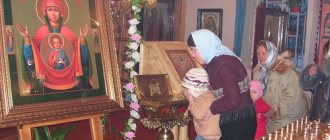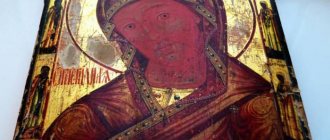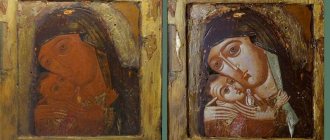The image of the Vladimir Mother of God is one of the most ancient and revered in Russia. The Vladimir Icon of the Mother of God is considered the patroness of the Russian people and Russia itself. The memory of the Presentation of the Vladimir Icon of the Mother of God is celebrated 3 times a year: June 3 (May 21, old style), July 6 (June 23, old style) and September 8 (August 26, old style).
History of the Kazan Icon. Finding a shrine
The image of the Mother of God appeared in Kazan in 1579, when this city could still hardly be called Russian. Only 27 years have passed since the capture of Ivan the Terrible by his troops in 1552, and even less since the founding of a separate diocese of the Russian Orthodox Church in 1553. The local population also had little sympathy for such a great event, since it was predominantly Muslim. Moreover, on the eve of the apparition - in June 1579 - the city was engulfed in a terrible fire, and many local residents considered this to be the malicious intent of Christians. Nevertheless, it was in this city and in this turbulent time that the Mother of God revealed Her honest image.
Kazan Bogoroditsky Monastery, Kazan.
The miraculous discovery of an icon in the ashes
The history of the Kazan Icon of the Mother of God from the day it was found is connected primarily with the protection of our country from troubles, primarily from enemy hordes. Many of these events were and are considered miraculous, just as the discovery of the icon itself was miraculous. It was preceded by one of the most terrible disasters that could happen in wooden cities at that time - a catastrophic fire. It passed through Kazan in 1579, a quarter of a century after the army of Tsar Ivan the Terrible stormed the capital of the Kazan Khanate.
Half of the Kazan Kremlin and the adjacent part of the city perished in the fire, and rumors arose among the Muslim population that in such a terrible way the infidels were given a sign from above, as if God was angry with them. And as if in response to this, the Mother of God appeared in a dream to one of the little residents of Kazan, the nine-year-old Streltsy daughter Matryona Onuchina, and ordered her to look for her icon in the ashes of a burnt house. But the girl did not immediately succeed in getting adults to listen to her words. The Mother of God appeared to her three times before at least Matryona’s mother agreed to go with her daughter to the ashes with a shovel in her hands. And almost immediately they came across an icon wrapped in an old sleeve of men's clothing made of cherry cloth. As the priest of the St. Nicholas Gostiny Dvor Church of Kazan, Ermolai, the future Patriarch of All Rus' Germonen, wrote in the work “The Tale and Miracles of the Most Pure Mother of God”, at the moment of discovery “the miraculous image shone wonderfully with lordship, as if it had been painted again with paints, while the dust of the earth did not touch it at all wonderful image."
“When an icon was found in the oven of one of the burnt houses - not burnt, but clearly placed there to save it from fire - it was perceived as a sign that despite all earthly misfortunes, such as fires, which often happened at that time, The Mother of God did not leave this place. This was turned into a state event, the icon was taken to Moscow, and the Kazan Church was built, which was restored in the 17th century. And this event began to be very revered by the people: in the burnt-out empty place, the image of the Mother of God still appears - as a sign of the appearance of herself,” says Alexander Kopirovsky
.
Appearance of the Kazan Icon
The phenomenon itself happened as follows. Some time after the fire, one nine-year-old girl - Matrona, the daughter of a archer of the royal army - begins to appear to the Mother of God Herself with the command to find Her image in one of the ashes. After the first appearance of the Mother of God, no one believed the girl. However, the Mother of God appears to Matrona more than once or twice, and the girl continues to turn to adults with a request to find the image. After some time, Matrona’s mother turns to the Orthodox priests with a request for help and a story about the miraculous vision of her daughter. However, the clergy doubt the truth of these phenomena and are in no hurry to find the image. Only after repeated persistent appeals to the Bishop of Kazan, it was decided to find the image of the Most Pure Mother of God. As a result, the image, wrapped in cloth, was found on one of the ashes. According to legend, the image was found only when Matrona herself began digging. At the site where the icon was found, by decree of the tsar, the Mother of God nunnery and church were built, and the first copy of it was sent to Moscow.
Time of Troubles
The history of the Kazan image in the history of the Time of Troubles is inextricably linked with the feat of St. Hermogenes, Patriarch of Moscow and All Rus', who was one of the first to defend Russia and the Orthodox faith from the invasion of Polish invaders, and equally from internal strife, which, perhaps, They even threatened the country to a greater extent at that time.
The first church, built in the 17th century, honors the Kazan Icon of the Mother of God in the village of Kolomenskoye. Photo from wikimedia.org/Ludvig14
Patriarch Ermogen, by the way, became the author of the “Tale” about the Kazan Icon of the Virgin Mary. This happened when he was still Metropolitan of Kazan in 1594. The full title of the “Tales” is “The Tale and Miracles of the Most Pure Mother of God, the Honest and Glorious Appearance of Her Image, Like in Kazan.” He also composed a service for this icon.
At the end of 1610, the situation in Russia became tense. It is widely known that at this time Polish aristocrats actively laid claim to power in the country, but it is important to remember why this became possible: the main misfortune of the country was not even an invasion from outside, but the anarchy generated by the civil war. Cities and influential boyar clans fought with each other. The country was filled with gangs of Cossacks and simply wandering seekers of easy money, who robbed, raped and killed. People who called themselves Orthodox, if they remained so, then only formally. Many behaved like real barbarians.
Patriarch Hermogenes was taken into custody. It was at this moment, having finally realized the destructiveness of the situation, the saint begins to send out his district messages to all regions of the state, calling for an end to the strife, to unite and to gather militias to liberate the country from enemies. In them, he especially calls not only to defend the country, but also to defend his Orthodox faith, and to prevent violence and cruelty towards ordinary people.
Under the influence of the patriarch’s speeches, a militia is formed in Nizhny Novgorod under the leadership of Prince Dimitry Pozharsky and Kuzma Minin. Soon it begins to move towards Moscow, visiting different cities along the way.
In Yaroslavl, Kazan residents also join the militia, bringing with them a copy of the Kazan Icon of the Mother of God and handing it over to Prince Demetrius. This happened already in 1611. From this moment, in fact, the Most Holy Theotokos becomes the head of the militia as the spiritual leader of the people.
By the autumn of 1612 the situation had become quite complicated. On the one hand, the Poles themselves, who took refuge in the Kremlin, were in a vicious circle - hunger, disease and discord were raging in their camp, and convoys sent to help from the outside were intercepted by the Russian militia. On the other hand, the camp of the Russian militia also had its own unrest. It became obvious that we could wait no longer. On the eve of the storming of the Kremlin, a three-day fast and intense prayer were announced in the ranks of the Russian militia in front of the Kazan image of the Mother of God.
There is an indication in historical sources of a miraculous phenomenon associated with the intercession of the Mother of God. At the time of the siege, Archbishop Arseny of Elasson was in the Kremlin, to whom St. Sergius of Radonezh appeared the night before the assault. According to legend, he told the archbishop the following: “Arseny, our prayers have been heard; through the intercession of the Mother of God, God’s judgment on the Fatherland was transferred to mercy; "Tomorrow Moscow will be in the hands of the besiegers, and Russia will be saved."
The next morning, October 22, 1612, Russian troops stormed Kitay-gorod, and two days later they liberated the entire Kremlin.
On October 25, 1612, Russian militias marched to the Kremlin in a religious procession, carrying ahead the Kazan Icon of the Mother of God, the main Intercessor of the Russian land.
According to the Nikon Chronicle, after the liberation of Moscow from the Polish invaders, Prince Dimitry Pozharsky left the Kazan image of the Virgin Mary in the Church of the Entry into the Temple of the Blessed Virgin Mary on Lubyanka. In 1636, this image was transferred to the newly built Kazan Cathedral on Red Square. This cathedral was also built in honor of the liberation of Moscow from the Poles.
Since 1649, this day, October 22, has become an all-Russian day of celebration in honor of the Kazan Icon of the Mother of God, who defended Russia in the Time of Troubles.
Kazan image in the War of 1812
In the Patriotic War of 1812, the mercy of the Mother of God towards the Russian people was again manifested, which She showed through Her honest Kazan image.
It is known that before leaving for the active Russian army, Field Marshal Mikhail Illarionovich Kutuzov prayed in front of the Kazan image of the Mother of God.
One of the most famous cases of the War of 1812, associated with the help of the Russian troops of the Kazan image, is the battle of Vyazma on October 22. On this day, which was the day of celebration in honor of the Kazan image, Russian troops of General Mikhail Andreevich Miloradovich and cavalry general Matvey Ivanovich Platov defeated the rearguard of the troops of the French Marshal Davout.
In this battle, in which the French lost about 7–8 thousand people, Napoleon’s army suffered its first defeat after leaving Moscow.
In 1811, the construction of the Kazan Cathedral was completed in St. Petersburg, which after the war of 1812 became a temple-monument to the Russian army. Subsequently, Prince Mikhail Kutuzov was buried in this cathedral. There is no doubt that the place to perpetuate the glory of the Russian army was not chosen by chance, since in the war of 1812 the Most Holy Theotokos, as in the years of the Time of Troubles, became the spiritual guide of the Russian people.
Image theft
From the moment of its appearance until the beginning of the twentieth century, the original icon was constantly in the Mother of God Convent of Kazan, that is, at the site of its miraculous appearance. However, when the troubled revolutionary years began for Russia, perhaps, for edification or humility, the Lord deprived her of this miraculous image. Many people of that era showed signs of apostasy from their native faith, from the faith of their fathers. Most likely, this was one of a number of reasons for the tragedy that occurred. Now, many years later, those events can be traced in sufficient detail.
On the night of June 28-29, 1904 (old style), the Kazan image of the Blessed Virgin Mary was stolen.
It is believed that the moment for the theft of the icon was not chosen by chance. For four days preceding the theft, the Smolensk Icon of the Mother of God, brought to the city, was in the monastery. In this regard, long holiday services were held in the monastery every day. On June 28, the Smolensk Icon was taken out of the monastery to return home. At the end of the all-night vigil, the nuns went to their cells. At the beginning of three o'clock in the morning, one of the novices, Tatyana Krivosheeva, went out into the courtyard of the monastery and heard cries for help coming from the direction of the bell tower. It turned out that it was the monastery watchman Fyodor Zakharov who was shouting. He was found locked in the basement of the cathedral.
Captured Bartholomew Chaykin
When examining the cathedral, a place was found through which the thieves got inside. The fact that these were thieves, and not just vandals, became clear when the loss of the Kazan image of the Mother of God and the icon of the Savior was established. Both icons were placed in the iconostasis. The icons were decorated with expensive vestments - this, apparently, attracted robbers. As noted later, in addition to the icons, 365 rubles of donations, which were stored in candle boxes, were also stolen.
The news of the theft of the miraculous image quickly spread not only to Kazan, but throughout Russia. Fortunately, thanks to the caretaker of the Aleksandrovsky vocational school Vladimir Volman (he gave the police very valuable information), the criminals were quickly found. As a result of coordinated, and most importantly, quick actions of all people who were not indifferent to this misfortune, the police very soon found the main suspect - a 28-year-old peasant, Bartholomew Chaikin (Stoyan). Already on July 5, he, together with his wife Praskovya Kucherova (officially she was his partner), was detained in Nizhny Novgorod, where they tried to escape from Kazan on the Niagara steamer.
During a search of Chaikin’s apartment, jewelry and pieces of decoration from the icons of the Virgin Mary and the Savior were discovered. However, the icons themselves were not found. According to 9-year-old Evgenia, the daughter of Chaikin’s partner, the icons were chopped up and burned in the stove. Similar evidence was given by several other persons who served as witnesses - in particular, it was Praskovya’s mother, Elena Schilling.
On November 25, 1904, the trial began in the Kazan District Court. Bartholomew Chaikin (Stoyan), Anania Komov (both direct participants in the crime), Fyodor Zakharov, Nikolai Maksimov (closest accomplices), Praskovya Kucherova and Elena Shilling (both who concealed the crime) appeared before the court as defendants.
After lengthy hearings, by a court decision, Bartholomew Chaikin (Stoyan) was sentenced to 12 years of hard labor, Anania Komov - to 10 years. Maksimov was sentenced to exile for 2 years 8 months in correctional prison units. Praskovya Kucherova and Elena Schilling were sentenced to 5 months and 10 days in prison. The watchman Fyodor Zakharov, who was suspected of complicity, was acquitted.
The main version of the fate of the icon was that it, like the image of the Savior, was burned by attackers. However, over time, other versions began to appear. For example, some suggested that Chaykin could have sold the icon to the Old Believers, since even without the frame it was very expensive. Her true fate is still unclear.
LiveInternetLiveInternet
St. Nikolai - Days of Remembrance : May 22, DecemberSaint Nicholas lived in the 4th century and was an archbishop in Asia Minor, in the Lycian city of Myra. He was born in the city of Patara and, even in his youth, was given to the service of God under the leadership of his uncle, the Bishop of Patara. His uncle elevated him to the rank of priest. During the consecration, the bishop, in a prophetic spirit, said that he would be a great shepherd, lead many lost to the truth and give consolation to all those who mourn. The whole life of the saint was really like this.
After the death of his parents, he distributed all his property to the poor. A certain rich city dweller, who had three adult daughters, fell into extreme poverty and, in order to provide for himself, was planning to give them away in an unlawful marriage. Having learned about this, St. Nikolai saved him and helped settle his daughters by secretly throwing a purse of gold out the window three times. The third time the father recognized the mysterious benefactor, lying in wait for him at the window. St. Nicholas settled in a monastery in Palestine, but one night, while standing in prayer, he heard a voice: “Nicholas, enter into a national feat if you want to receive a crown from me.” Then he realized that the Lord was demanding from him non-monastic service and went to Myra. At this time, a new bishop was being elected here and those who elected, not knowing whom to elect, prayed to God that He Himself would indicate the worthy one. Then one of the bishops was told in a dream to stand at the church door and watch whoever with the name Nicholas enters the church first, he is God’s chosen one. St. Nicholas, having arrived in Myra, went to the church the next morning and was the first to enter it. The bishop recognized him as God's chosen one, and the council of archpastors appointed him bishop of the city of Myra, although he refused.
Having become a bishop, St. Nicholas devoted all his labors to the good of his flock: he received everyone with fatherly love, listened to petitions and complaints, and firmly defended the innocently persecuted. During the persecution of Diocletian, he was imprisoned, and here he consoled all the prisoners. With the accession of Constantine the Great, it was returned to its flock. St. Nicholas was present at the First Ecumenical Council against Arius. One day he learned that three of the citizens were innocently condemned to death, he hurried to the place of execution, snatched the sword from the hands of the executioner and thus saved the innocent. Saint Nicholas died at a very old age, and his relics were placed in the cathedral Church of Mir.
Having performed many miracles during his lifetime, he did not stop performing them after his death, especially when enshrining his relics. His name became known to the entire Church, and he was called the Wonderworker. On December 6, the memory of St. Nicholas is celebrated; On May 9 (May 22 - new style) the transfer of the relics of this saint from Myra in Lycia to the city of Bar, located on the Apulia peninsula in Italy, is celebrated. This happened 7 centuries after the death of the saint and this is how.
In the 11th century, the Turks began their attacks on the Greek Empire, during which the shrines of Christians - temples, relics and icons - were desecrated. There was an attempt to desecrate the relics of St. Nicholas, but a terrible storm with thunder and lightning stopped this attempt, and then the Apulians had a desire to transfer the relics of St. Nicholas to themselves in order to save them from desecration. The Apulians were still Orthodox at that time and were dependent on the Greek Church. The saint himself ordered that his relics be transferred to Bar, appearing to one pious priest in Bar. And this transfer took place in 1087. On May 9, the Apulians met St. relics, they built a temple for them, which is why the feast of the transfer of relics was established on May 9. The relics rest in a marble shrine, which is located in the dungeon under the church.
Where is the Kazan Icon located?
Nowadays. Return
The story of the Kazan Icon has taken a new turn in our days. In 2004, the Vatican received a proposal for a meeting between Pope John Paul II and His Holiness Patriarch Alexy II. The pretext was the presence at the papal court since 1993 of an image of the Blessed Virgin Mary of unknown origin. After analyzing the situation, art historians came to the conclusion that this icon is one of the copies of the Kazan image.
The Kazan Icon of the Mother of God (pictured) was returned to Kazan. Itar-Tass Photos
And although the meeting between the Patriarch and the Pope never took place, in August 2004 the icon was delivered to Moscow by a Catholic delegation headed by Cardinal Walter Kasper. On August 28, it was handed over to Patriarch Alexy II in the Assumption Cathedral of the Moscow Kremlin. It was decided to move the image to Kazan, and until that time it was kept in the residence of the patriarch.
In July 2005, while on an archpastoral visit to Kazan, Patriarch Alexy II celebrated the Liturgy in the Annunciation Cathedral of the Kazan Kremlin. At the end of the service, the Kazan Icon of the Mother of God, brought from the Vatican, was handed over to the Kazan diocese. The icon was placed where the original once stood - in the Church of the Exaltation of the Cross of the former Mother of God Monastery. Thus, we can say that the second discovery of the image of the Mother of God took place in Kazan.
HISTORY OF THE ICON OF THE KAZAN MOTHER OF GOD
In 1579, a fire occurred in the city of Kazan, as a result of which the holy face of the icon of the Mother of God “Kazan” appeared in a striking way. A little girl named Matrona, who was the daughter of a merchant, helped find this shrine.
On the night of the fire, in a dream she saw the Most Holy Image of the Virgin, who ordered her to go to the fire with her mother. The merchant's daughter went to the fire with her mother and with her help was able to remove the icon of the Kazan Most Pure Virgin from under the rubble. The surprise of the common people was boundless, since the Holy of Holies was bright, very beautiful, the coloring was fresh, as if it had just been painted.
Subsequently, on the spot where the girl Matrona and her mother discovered the Immaculate Icon, a convent was erected, and the Holy of Holies was transported to the Assumption Cathedral in the city of Kazan.
In 1904, the icon was stolen because it was of considerable value. According to some witnesses, the miraculous face was destroyed, so at present only a copy of the Mother of God “of Kazan” is presented to the people.
Lists of the Kazan Icon
The icon of the Holy Trinity Cathedral is one of the ancient copies of the miraculous prototype. This image was painted in the 18th century. Subsequently, the icon was rewritten several times. The original image was hidden by several layers of later recording. In 2005, the icon was restored.
Throughout Russia itself there were many revered copies of the Kazan Icon of the Mother of God. The history of the veneration of this image is largely connected with them.
List in the militia
For example, one of the revered copies of the Kazan Icon was constantly in the camp of the Russian militia of Prince Dimitry Pozharsky during the war with the Polish and Swedish invaders in 1611–1613. In memory of the liberation of Moscow from Polish troops, it was established to hold a special celebration in honor of the Kazan Icon of the Mother of God on October 22. At first, the celebration took place only in Moscow, but since 1649 the celebration has become all-Russian.
Around the same time, the first church was built in honor of the Kazan Icon of the Mother of God in the village of Kolomenskoye.
Petersburg list
In the 18th century, both Peter I and Catherine the Great showed their attention and respect for the image of the Mother of God. So, for example, it was under Peter I, in 1721, that one of the revered copies of the Kazan Icon was brought to St. Petersburg. And earlier, in 1709 (on the eve of the Battle of Poltava), the entire Russian army, led by the emperor, prayed before the Kazan Icon for victory. In 1768, the original icon, located in Kazan, was especially venerated. Empress Catherine the Great decorated the frame of the image with a diamond crown.
The shrine of St. Petersburg, brought to the city in the first days of its creation by Peter I. Located in the Kazan Cathedral.
By the end of the 19th century, the Kazan icon became one of the most revered in Russia. Moreover, this applies to the entire Orthodox population of the country. It would hardly be possible to find a believer at that moment who did not know the Kazan image of the Virgin Mary or at least one of its many revered copies.
HOW WILL AN ICON HELP?
The icon of the Mother of God is mainly presented as the image of the guidebook Hodegetria, who from time immemorial has helped the people in finding their own true path.
During military operations in Moscow, numerous troops were sent under the protection of Hodegetria; they soon brought liberation of the population from enemies or Polish impostors.
A well-known fact is that it was Peter I who, in front of this image of the Most Holy Theotokos, pronounced one of the most powerful prayers, which is known to this day.
According to historical data, in 1812, the icon of the Mother of God “Kazan” helped Russian troops repel the advance of the French invaders and at the same time gain victory for the Russian troops during Napoleon’s offensive during the Patriotic Battle. It is believed that even Prince Mikhail Kutuzov stood in front of the icon, praying and thereby directing his own active army.
However, help, salvation and blessing from the holy of holies can be received not only by the great governor and ruler of the state, but also by simple ordinary people who, on their own behalf, turn to the holy face of “Kazan” for assistance. That is why at present it is impossible to count the number of miraculous cases that she gave to people.
Kazan icon in Moscow
Patriarchal service on the feast of the Kazan Icon of the Mother of God in the Kazan Cathedral on Red Square
In the Russian capital there are many churches where you can pray before the icon of the Kazan Mother of God. First of all, this is the Kazan Cathedral on Red Square. The temple was restored in 1993. Here is the revered image of the Kazan Icon.
At the bottom of the Cathedral of Christ the Savior in the Church of the Transfiguration of the Lord there is a recently painted Kazan Icon of the Mother of God. Parishioners of the capital's cathedral often pray in front of it.
In the Church of the Prophet Elijah in Obydensky Lane, among the shrines you can find the Kazan Icon. There is also a piece of the belt of the Blessed Virgin Mary. The temple is open daily from 07.00 to 22.00.
In the Yelokhovsky Cathedral near the Baumanskaya metro station there is a copy of the miraculous Kazan Icon of the Mother of God, which was previously in the Kazan Cathedral on Red Square.
Kazan Icon of the Mother of God with St. Timothy and Mary Magdalene in the fields. Russia, late 18th century
In the Church of the Intercession of the Mother of God on Lyshchikova Mountain between the Kurskaya and Taganskaya metro stations, you can also pray in front of the Kazan Icon. And also venerate the relics of priest Roman Medved, who died in the late 30s in Maloyaroslavets after numerous arrests and exiles.
In the Church of St. Pimen the Great near the Novoslobodskaya metro station you can see the Kazan Icon painted on glass.
The Church of St. Nicholas the Wonderworker on Bersenevskaya Embankment near the Kremlin is one of the most unusual in Moscow. Long services with many Old Believer traditions are held here. In the church you can pray in front of the revered copy of the Kazan Icon.
Of course, these are not all churches in the capital where there is this image of the Virgin Mary. It is more difficult to find a church in Moscow where there is no Kazan Icon of the Mother of God.
__________________________________________________________
Description of the Kazan Icon
The Kazan icon is a shortened (shoulder-length) version of the image of the Hodegetria (Guide) type. The Child Christ sits in the arms of the Mother of God, with His right hand He blesses, and with His left He holds a scroll, or less often, a book.
On the Kazan Icon, the Mother of God is depicted with a full chest, in characteristic clothes, with a slight inclination of her head towards the Infant God. Christ looks directly at the man in front of the icon, the Savior is depicted from the waist up, only his right hand is visible with a blessing gesture.
For more information about the iconography of the Kazan Icon of the Mother of God, see here .
Image Features
Researchers have recognized that the author of the icon used the image of the Blachernae Hodegetria (Guide) as an example. There is also the following characteristic.
- The position of the Mother of God is shortened (to the shoulders).
- The icon shows the head of the Mother of God bowed towards the baby. Christ is depicted from the front, blessing with his right hand. Jesus is depicted in his mother's arms, visible from the waist up.
- Scientists note that the iconography of the image is not entirely familiar: the baby’s second hand is not visible, it seems to be covered. This interpretation allows us to assume that the Kazan icon was painted in the 16th century, trying to introduce unusual and new features.
- The Kazan icon is small in size, which distinguishes it from other shrines: 26.7x22.3 cm (approximately).
- Those who managed to see the holy face with their own eyes noted that a soft (unearthly) light and a special peace emanated from the icon. The image was clean and not at all contaminated after the fire. Evidence can be considered from the memoirs of the Patriarch of All Rus' Hermogenes, who accepted the icon to transfer it to the temple.
- Over time, a small image of the Virgin Mary and Jesus was decorated with vestments made of gold and precious stones. Several of the richest vestments were intended for various church celebrations: when the procession of the Cross took place and large church services were held; on ordinary days, a chasuble made in Moscow was also provided, but more delicate, pearl, with roses decorated with diamonds.
In 1579 the icon was transported to Moscow. Such a shrine deserved special honors. Ivan the Terrible ordered the construction of the Kazan Cathedral, where the miraculous image of the Queen of Heaven and Jesus could be seen by thousands of Christians.
Kazan Icon: How the Mother of God Helps
Kazan Icon of the Mother of God. Moscow, first half of the 18th century.
According to the teachings of the Orthodox Church, one cannot assume that this or that icon helps with anything. Metropolitan Anthony of Sourozh said that a newly painted image becomes a shrine only after its consecration. Until this point, the new icon is simply an image of Christ, the Mother of God or a saint, which is made with paints on wood. Christians do not worship the material with which this or that image is painted. At the VII Ecumenical Council, the dogma of icon veneration was adopted. It directly states that “the honor given to the image passes to the original, and the one who worships the icon worships the being depicted on it.”
Another thing is that some icons are considered miraculous, since Christ, through prayers in front of certain shrines, helps people and entire nations. Therefore, the Kazan Icon of the Mother of God was especially revered in Rus', and the Mother of God, through the prayers of people in front of her image, more than once healed the sick or saved the country from destruction.
Prayer before the icon of the Kazan Mother of God has saved Russia more than once. This was the case at the beginning of the 17th century, when Moscow was captured by the Poles. In the militia of Minin and Pozharsky there was a miraculous image of the Mother of God, and after fervent prayers people were able to liberate the Kremlin from the invaders in 1613.
In 1812, Russia was attacked by Napoleon’s army, and again prayer in front of the image of the Kazan Mother of God helped to cope with the invaders. The army of thousands of the famous commander fled from Russia.
The same thing happened during the Great Patriotic War. There are several stories about how the Mother of God helped people survive the horrors of war, and soldiers helped defeat a terrible enemy. Prayer helped soldiers in battles.
_________________________________________________________
WHAT IT HELPES WITH: HOW TO PRAY, WHAT THE KAZAN ICON IS ASKED FOR
The icon of the “Kazan” Mother of God is in fact a truly miraculous face. In time immemorial, local residents, that is, ordinary people, kings, princes, turned to this icon with various requests for help.
Such a shrine was a patroness, since it was of no small importance for the common people, and according to ancient beliefs, the miraculous icon helped people heal from various diseases. Some people say that with the help of such a face they were given long-lost sight. The princes and kings of that time believed that the holy image helped in the fight against enemies and enemies, and also contributed to the liberation of the state from invaders.
In fact, the image can perform various miraculous things, which is why most people who find themselves in an unpleasant situation or are faced with any difficulties can turn to the Mother of God “of Kazan” for help and rush to her in prayer to ask for this or that help. The image of the intercessor can be placed in your own home or presented to loved ones.
How and about what it is necessary to send prayers to the image of the Mother of God “of Kazan”, its significance, the ability to protect and help people, you can learn about all this from this article.
Prayer before the Kazan Icon
Prayer before the Icon of the Mother of God “Kazan” (October 22/November 4 and July 8/21)
O Most Holy Lady Theotokos! With fear, faith and love before Your honest (and miraculous) icon, we pray to You: do not turn Your face away from those who come running to You. Pray, merciful Mother, to Thy Son and our God, the Lord Jesus Christ, to keep our country peaceful, and to keep His Holy Church unshakable from unbelief, heresies and schism let him deliver. There are no other help, no other hope, except You, Most Pure Virgin: You are the all-powerful Helper and Intercessor of Christians. Deliver all those who pray to You with faith from the falls of sin, from the slander of evil people, from all temptations, sorrows, illnesses, troubles and from sudden death. Grant us the spirit of contrition, humility of heart, purity of thoughts, correction of sinful lives and the remission of sins, and all of us, gratefully chanting Your greatness and mercy, which are revealed to us here on earth , let us be worthy of the Heavenly Kingdom, and there with all the saints we will glorify the most honorable and magnificent name Father, and Son, and Holy Spirit forever and ever. Amen.
PRAYERS TO THE KAZAN FACE OF THE HOLY
Oh, Most Holy Lady and Lady Theotokos! With fear, faith and love, falling before Your honorable icon, we pray to You: do not turn Your face away from those who come running to You. Pray, merciful Mother, to Thy Son and our God, the Lord Jesus Christ, to preserve our country peacefully and to keep His holy Church unshakable from unbelief, heresies and schism. There are no imams of any other help, no imams of other hope, unless You, Most Pure Virgin, are You the all-powerful Helper and Intercessor of Christians. Deliver all who pray to You with faith from the falls of sin, from the slander of evil people, from all temptations, sorrows, troubles and from vain death. Grant us the spirit of contrition, humility of heart, purity of thoughts, correction of sinful lives and the remission of sins, so that we all sing gratefully of Your greatness, we will be worthy of the Heavenly Kingdom, and there with all the saints we will glorify the Most Honorable and Magnificent Name of the Father and the Son and the Holy Spirit. Amen.
Oh, Most Holy Lady Theotokos, Queen of Heaven and earth, the highest angel and archangel and all creatures, the most honest, pure Virgin Mary, good Helper to the world, and affirmation for all people, and deliverance in all their needs! Look now, O All-Merciful Lady, upon Thy servants, Praying to You with a tender soul and a contrite heart, falling with tears to You and worshiping Your most pure and wholesome image, and asking for Your help and intercession. Oh, All-Merciful and Most Merciful Virgin Pure Mother of God! Look, O Lady, at Thy people: for we are sinners and imams of no other help than to You and from You, Christ our God born. You are our intercessor and representative. You are protection for the offended, joy for the sorrowing, refuge for the orphans, guardian for widows, glory for virgins, joy for those who weep, visitation for the sick, healing for the weak, salvation for sinners. For this reason, O Mother of God, we resort to You, and hold Your Most Pure Image with the Eternal One in Your hand As an infant, our Lord Jesus Christ, looking at You, we offer tender singing and cry: have mercy on us, Mother of God, and fulfill our request, for all things are possible through Your intercession, for glory is due to You now and ever and unto the ages of ages. Amen.
Source
Troparion of the Kazan Icon
Troparion of the Kazan Icon of the Mother of God, tone 4
Zealous intercessor, Mother of the Most High Lord. Pray for all, thy Son Christ our God, and cause all to be saved, into thy sovereign protection for those who flee. Intercede for us all, O Lady Queen and Lady! even in adversity and sorrow, and in illness, burdened with many sins, coming and praying to you with a tender soul and a contrite heart, before your most pure image with tears, and irrevocably hope I am waiting for those who have it, for the deliverance of all evils. Grant what is useful to everyone, and save everything, O Virgin Mary: for you are the divine protection of your servant.
Troparion, kontakion and canon of the Vladimir Icon of the Virgin Mary
Troparion, tone 4.
Today the most glorious city of Moscow shines brightly, as the dawn of the sun has received Your miraculous icon to the Lady. We are now flowing to her, and praying to You, we cry out to You, O Most Wonderful Lady Theotokos, praying from You to the incarnate Christ our God, may He deliver this city, and all Christian cities and countries unharmed, from all the slander of the enemy, and save our soul, as He is merciful .
Kontakion, tone 8.
To the Chosen Voivode and Intercessor, the Virgin and Mother of God, established in a clear conscience by the faith of the Russian people, who has irrevocable hope as a harbinger, and especially to Her miracle-working and Most Pure Image, and crying out to Her, Rejoice, Unmarried Bride.
Library of the Russian Faith Canon of the Vladimir Icon of the Blessed Virgin Mary →
Read online
